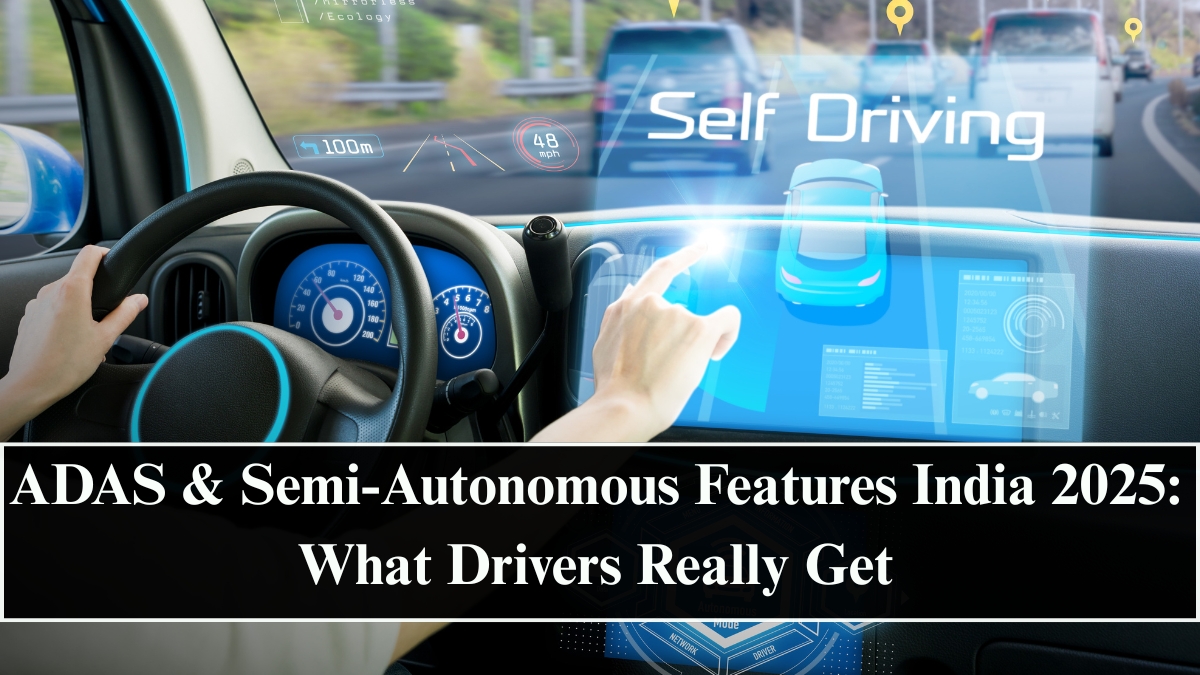The Indian automotive landscape is undergoing a high-tech transformation, and ADAS Features India SUVs 2025 are at the forefront of this revolution. What was once exclusive to luxury vehicles has now reached mid-range SUVs, offering advanced driver assistance systems that make driving safer, smoother, and more intelligent than ever before.
By 2025, Indian roads are seeing a new generation of semi-autonomous cars equipped with adaptive technology — helping drivers stay alert, avoid collisions, and even handle traffic more efficiently.

Understanding ADAS: The Core of Assisted Driving
ADAS (Advanced Driver Assistance Systems) refers to a suite of technologies that use sensors, cameras, radar, and artificial intelligence to monitor surroundings and assist the driver in real-time. These systems don’t replace human control entirely but act as an intelligent co-pilot to reduce errors and improve safety.
Common ADAS features include:
-
Adaptive Cruise Control (ACC) – Automatically adjusts speed to maintain a safe distance from the vehicle ahead.
-
Lane Keep Assist (LKA) – Gently steers the car back into its lane if it drifts unintentionally.
-
Automatic Emergency Braking (AEB) – Detects obstacles and applies brakes to prevent or minimize collisions.
-
Blind Spot Detection (BSD) – Alerts the driver about vehicles approaching from the blind side.
-
Traffic Sign Recognition (TSR) – Identifies road signs and displays them on the dashboard for better awareness.
In 2025, these features are increasingly available even in SUVs under ₹20 lakh, signaling a massive leap in semi-autonomous car technology for the Indian market.
How Indian Automakers Are Adopting ADAS
Leading automakers such as Tata Motors, Mahindra, Hyundai, MG, and Honda are heavily investing in ADAS integration for their latest SUV lineups. The Mahindra XUV700, Hyundai Tucson, and MG Astor were among the first models to introduce Level 2 ADAS capabilities in India.
By 2025, more brands are expanding this technology to vehicles like the Tata Harrier, Safari, and Hyundai Creta EV. These systems use a combination of radar and camera-based sensors to deliver features like collision warning, drowsiness detection, and adaptive lane assistance, making Indian driving conditions significantly safer.
The Safety Impact: Reducing Accidents and Driver Fatigue
According to government data and independent automotive studies, driver error is responsible for over 80% of road accidents in India. The rise of ADAS cars India 2025 directly addresses this issue by adding a second layer of safety through automation and predictive assistance.
For instance, in highway driving, adaptive cruise control and lane-keep assist can maintain consistent speed and alignment, reducing fatigue during long trips. Similarly, in city traffic, features like auto emergency braking and pedestrian detection prevent sudden collisions — crucial for dense urban areas.
Semi-Autonomous Features and India’s Unique Road Challenges
Unlike Western countries, India’s road environment presents unique challenges: irregular lane markings, two-wheelers weaving between cars, and unpredictable pedestrian movement. Automakers are customizing ADAS systems with region-specific algorithms to handle these variables.
Cameras and radars are being recalibrated to detect smaller vehicles, recognize imperfect road patterns, and interpret complex traffic behavior. This localization ensures ADAS functions effectively in both metropolitan highways and smaller regional roads.
The Legal and Infrastructure Side
The Ministry of Road Transport and Highways (MoRTH) is actively working on automotive safety regulations that cover driver assistance technologies. As part of India’s broader road safety mission, these policies aim to make Level 1 and Level 2 ADAS mandatory for new vehicles by the late 2020s.
Meanwhile, testing facilities across Chennai, Pune, and Bengaluru are being upgraded for autonomous vehicle trials, ensuring that the technology meets Indian safety and performance standards. This gradual transition toward self-driving systems will rely heavily on public infrastructure — including better lane markings, connected traffic systems, and reliable digital maps.
The Future of Driving: Comfort Meets Intelligence
By 2025, semi-autonomous SUVs in India are bridging the gap between manual driving and full autonomy. Drivers are already experiencing vehicles that can steer, brake, and accelerate intelligently — all while keeping safety the top priority.
With growing consumer demand for comfort, technology, and reliability, the ADAS revolution is making driving less stressful and more enjoyable. As AI and sensor technology continue to evolve, the next phase of Indian mobility will see even smarter systems capable of self-parking, highway autopilot, and voice-integrated driving modes.
FAQs
What is ADAS in cars?
ADAS stands for Advanced Driver Assistance Systems — technologies that assist the driver in controlling the car safely using sensors, cameras, and AI-based systems.
Which SUVs in India have ADAS in 2025?
Popular models include Mahindra XUV700, Hyundai Tucson, MG Astor, Tata Safari, and Honda Elevate — all offering varying levels of ADAS features.
Are ADAS-equipped cars safer?
Yes. ADAS features reduce human error by providing automated support in braking, steering, and speed control, significantly lowering accident risks.
What level of autonomy do Indian SUVs offer?
Most SUVs in India in 2025 offer Level 1 or Level 2 autonomy, meaning they assist but do not replace the driver. Full self-driving is still under testing phases.
Does ADAS work on Indian roads?
Yes. Automakers are customizing ADAS systems to adapt to Indian road conditions, recalibrating sensors and AI algorithms for real-world traffic scenarios.
Click here to know more.
